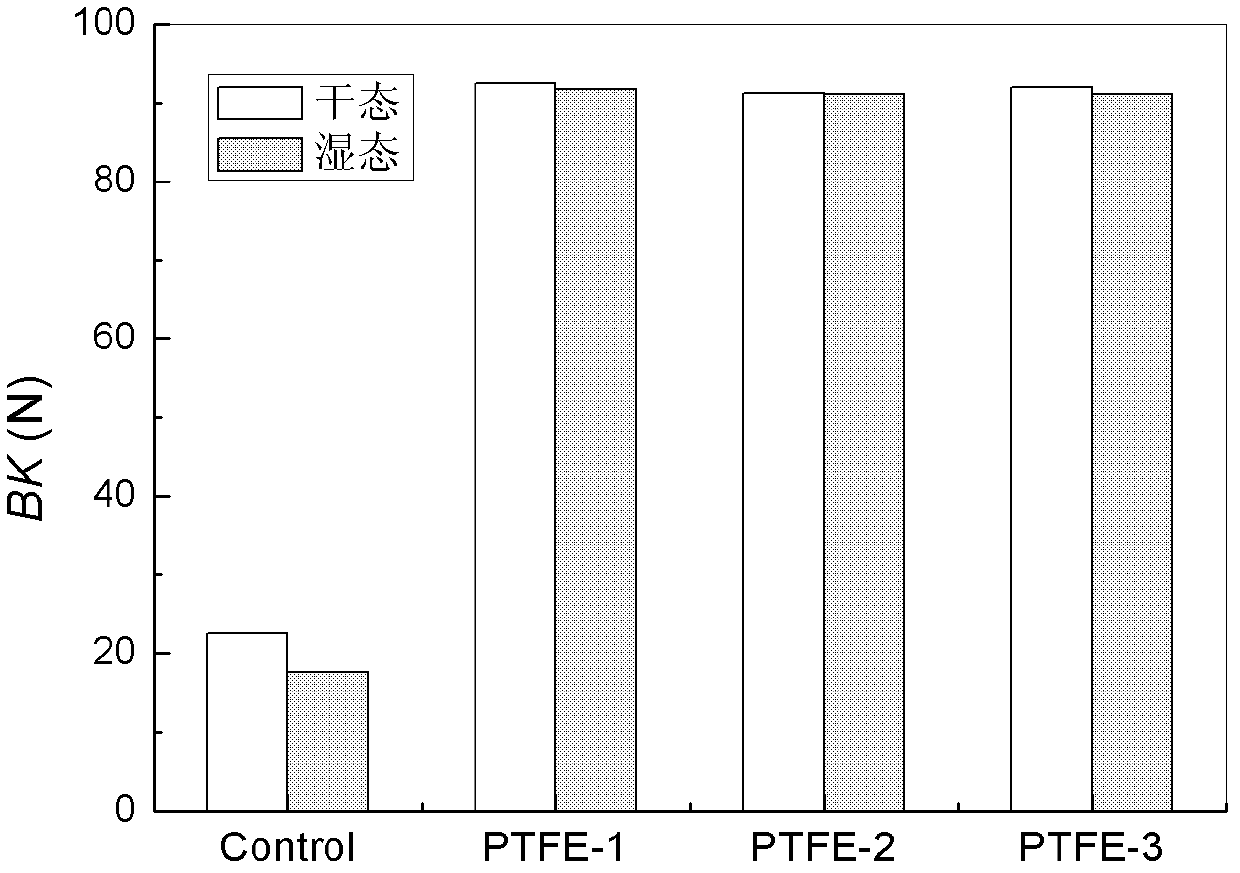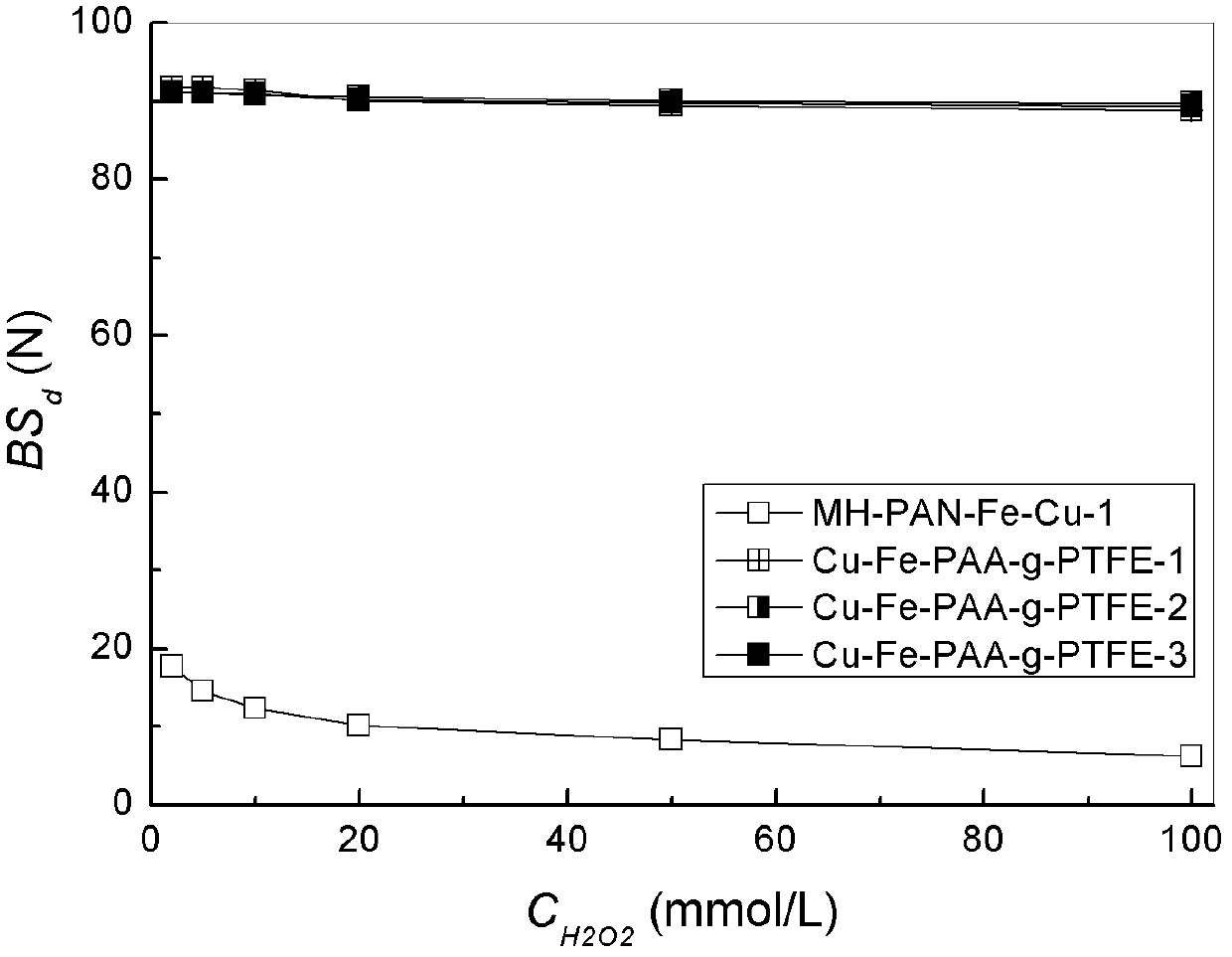Modified Teflon fiber metal complex catalyst and preparation method thereof
A polytetrafluoroethylene and fiber metal technology, which is applied in the field of polytetrafluoroethylene fiber metal complex catalyst and preparation, can solve the problems of the limitation of modified polyacrylonitrile fiber catalyst, the easy falling off of metal ions, insufficient chemical stability and the like, Achieve the effect of easy industrialization, excellent mechanical strength and excellent mechanical strength
- Summary
- Abstract
- Description
- Claims
- Application Information
AI Technical Summary
Problems solved by technology
Method used
Image
Examples
Embodiment 1
[0037] 1. Pretreatment of polytetrafluoroethylene fibers: at room temperature and under stirring conditions, first wash and treat the polytetrafluoroethylene fibers with an aqueous solution of non-ionic surfactant with a volume concentration of 2.0g / L for 10 minutes, take them out, wash them with water and dry them , and then use acetone to clean the polytetrafluoroethylene fiber for 10 minutes, take it out and dry it in vacuum at 50°C for 24 hours before use;
[0038] 2. the acrylic acid graft modification reaction of polytetrafluoroethylene fiber: accurately weigh the described pretreated polytetrafluoroethylene fiber of design weight, and its immersion volume concentration is the acrylic acid monomer of 360g / L and volume concentration is 16g / L ferrous ammonium sulfate mixed aqueous solution. The ratio of the polytetrafluoroethylene weight (grams) to the volume (milliliters) of the mixed aqueous solution is 1: 30; then feed nitrogen into the system for 10 minutes to drive aw...
Embodiment 2
[0043] 1. Pretreatment of polytetrafluoroethylene fibers: at room temperature and under stirring conditions, first wash and treat the polytetrafluoroethylene fibers with an aqueous solution of non-ionic surfactant with a volume concentration of 4.0g / L for 10 minutes, take them out, wash them with water and dry them ; Then use acetone to clean the polytetrafluoroethylene fiber for 20 minutes, take it out and dry it in vacuum at 60°C for 36 hours before use;
[0044] 2. The acrylic acid graft modification reaction of polytetrafluoroethylene fiber: accurately weigh the described pretreatment polytetrafluoroethylene fiber of design weight, and it is immersed in the acrylic acid monomer that volume concentration is 420g / L and volume concentration is 18g Graft modification in the ferrous ammonium sulfate mixed aqueous solution of / L; The ratio of the polytetrafluoroethylene weight gram to the volume milliliter of the mixed aqueous solution is 1:30; Then feed nitrogen into the system ...
Embodiment 3
[0049] 1. The 1st step process of embodiment 3 is identical with the 1st step process among the embodiment 1;
[0050] 2. the 2nd step process of embodiment 3 is adjusted to 500g / L and 20g / L respectively by the acrylic acid in the 2nd step process of embodiment 1 and ferrous ammonium sulfate volumetric concentration, and Co 60 The γ-ray radiation treatment time is adjusted to 100h, and all the other are the same as the second step process in Example 1. After the reaction, the light red graft modified polytetrafluoroethylene fiber is abbreviated as PAA-g-PTFE-3;
[0051] 3. The 3rd step process of embodiment 3 adjusts the molar concentration ratio of iron ion and copper ion in the metal ion mixed aqueous solution described in the 3rd step process of embodiment 1 to 1: 3, i.e. ferric chloride aqueous solution and copper sulfate aqueous solution The volume concentrations are 0.025mol / L and 0.075mol / L, respectively. All the other are with the 3rd step process among the embodiment...
PUM
| Property | Measurement | Unit |
|---|---|---|
| Volume concentration | aaaaa | aaaaa |
| Volume concentration | aaaaa | aaaaa |
Abstract
Description
Claims
Application Information
 Login to View More
Login to View More - R&D
- Intellectual Property
- Life Sciences
- Materials
- Tech Scout
- Unparalleled Data Quality
- Higher Quality Content
- 60% Fewer Hallucinations
Browse by: Latest US Patents, China's latest patents, Technical Efficacy Thesaurus, Application Domain, Technology Topic, Popular Technical Reports.
© 2025 PatSnap. All rights reserved.Legal|Privacy policy|Modern Slavery Act Transparency Statement|Sitemap|About US| Contact US: help@patsnap.com



